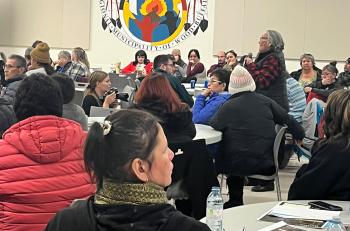Image Caption
Summary
Local Journalism Initiative Reporter
Windspeaker.com
Anger, distrust and fear were evident in the first community meeting hosted by an Imperial Oil official since news broke last month of tailings pond seepage that had been occurring since May 2022 at the Kearl mine upstream of Indigenous communities in the Fort Chipewyan area. Members of the Athabasca Chipewyan First Nation, Mikisew Cree First Nation and the Fort Chipewyan Métis were in attendance.
Jamie Long, Imperial’s vice-president of oil sands mining, had little chance to offer information to those crowded into the Fort Chipewyan community hall March 22 before a man stopped close to him and angrily shouted about Imperial Oil not disclosing the environmental concerns to the community or to the governments of Alberta and Canada.
Industrial wastewater has been escaping the external tailings area, both on and outside the boundaries of the Kearl site, since May 19, 2022, when Imperial made its first report to the Alberta Energy Regulator.
However, the Indigenous communities weren’t notified until Feb. 6 this year when the AER issued an environmental protection order (EPO). On Feb. 4, at least 5.3 million litres of toxic chemicals overflowed from a dam at the Kearl mine into the environment. The wastewater exceeds federal and provincial guidelines for iron, arsenic, sulphates and hydrocarbons that could include kerosene, creosote and diesel.
“Are you a scientist? Are you a health professional? Can you tell us the cumulative effects that are going to happen…to our traditional way of life?” the man asked.
Both the lack of notification from May’s incident and the impact of cumulative effects on hunting, harvesting and fishing and related health concerns were raised over and over again at the meeting.
Long said Imperial took the situation “very seriously,” pointing out that Kearl had been developed over a decade ago and this was the first time the facility had been issued an EPO.
“There are a lot of things we could have done much better,” said Long. “We regret the incidents and we’re making every effort to ensure we prevent them from happening again.”
However, Long said that email notification of “discoloured water” was sent in May to the ACFN.
On March 23, Windspeaker.com was provided with that email by ACFN. It reads, “…Imperial’s environmental consultant reported discoloured water and vegetation north and north-east of the Kearl lease boundary during recent routine groundwater sampling. Imperial is launching a dedicated team to understand the source of the water and any potential environmental impacts.”
Jay Telegdi, ACFN’s senior manager of intergovernmental affairs, told Windspeaker.com that in three meetings between Imperial and ACFN “where exactly this sort of stuff is supposed to be discussed” and in a face-to-face meeting with ACFN Chief Allan Adam and Long following that May 19 email, Imperial did not disclose any further information about the seepage.
Long outlined the remedial work that was being undertaken by “the more than 200 people on the site.”
He said the communities were being asked to provide feedback on Kearl’s proposed remedial plan. He said independent sources were gathering data, such as water samples, and more wells were being drilled in order to monitor the water.
However, that information was met with skepticism.
“Something is not right. You’re holding back something and not telling us the truth,” said one man.
Only two days before, the ACFN released a statement that their observations of the spill site north of the Kearl tailings pond was “worse than what anyone anticipated.”
ACFN itemized a number of concerns, including animal tracks in the spill area; no barriers placed between seepage and water bodies; new tailings puddles forming as the temperature increased; and that a pump and drains apparently had only recently being installed to deal with the situation.
Long said “a group of individuals” would be welcomed on site to see the work that was being undertaken. He reminded them that safety protocols had to be followed as Kearl was a working mine.
Long’s ability to follow through on concerns raised by members was questioned.
“Do you have a mandate to do anything based on what the community is telling you is an issue? Because you say you’re going to take it back, but did you come here with a mandate to have any dialogue with the community on what you’re going to do going forward?” asked one woman.
Long said that while he was responsible for “everything that happens at Kearl,” he couldn’t commit to delivering on everything that was being asked of him.
Community members complained that the scheduled one-hour meeting was too short. The information session ran about 90 minutes.
Long agreed to return in April to answer more questions.
Also yesterday, Information and Privacy Commissioner Diane McLeod announced an investigation into AER and whether the regulator was obligated under section 32 of the Freedom of Information and Protection of Privacy Act to disclose information to the public or others about the tailings pond leak from the Kearl site. However, McLeod did not commit to making the investigation public upon its conclusion.
Never miss a Windspeaker article. Subscribe Today to our new Windspeaker Newsletter!
Local Journalism Initiative Reporters are supported by a financial contribution made by the Government of Canada.

